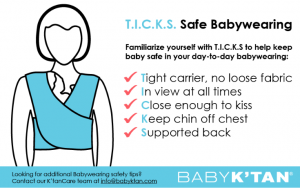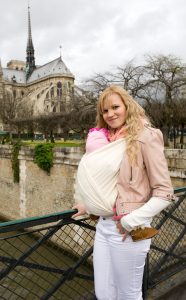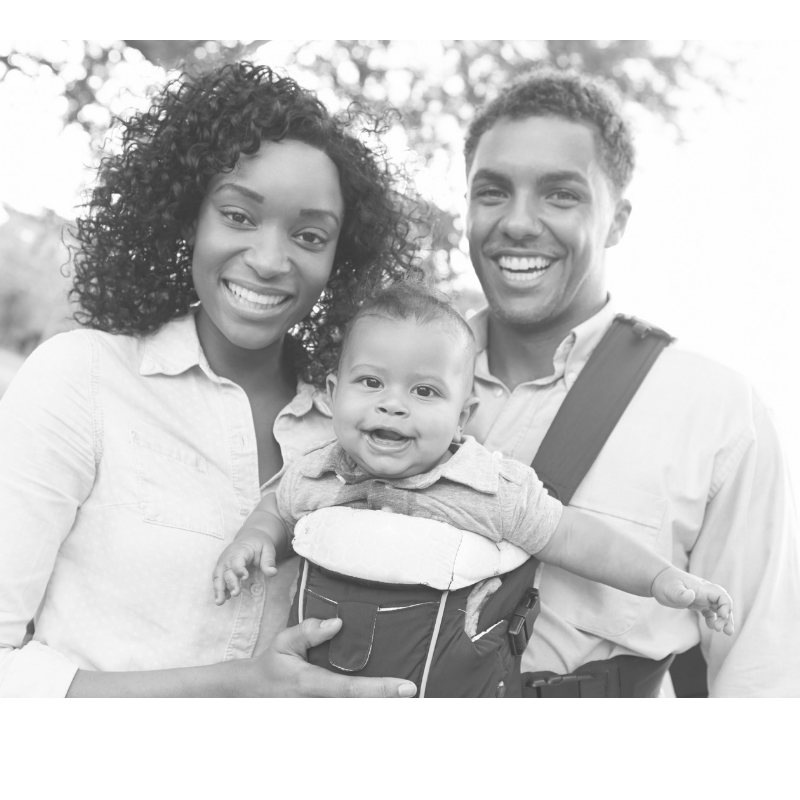Babywearing has become much more mainstream in the past few years. Carriers are readily available and can be found at all price points. Not only is it convenient to wear your little one, but it allows you the freedom to go places where strollers cannot. Did you know carried babies cry less*?
Babywearing Safety Tips
 When used correctly baby wraps and baby carriers are safe. If you’ve looked into babywearing, you may have seen this graphic or acronym. This is a great starting point! There are a few points we would like to add/clarify.
When used correctly baby wraps and baby carriers are safe. If you’ve looked into babywearing, you may have seen this graphic or acronym. This is a great starting point! There are a few points we would like to add/clarify.
Tight Carrier, No Loose Fabric
Observe and follow the weight guidelines for the carrier. They were created by the manufacturer with your baby’s safety in mind. If your baby does not meet the minimum weight requirement, the carrier may not be as snug as intended. This can lead to slouching and a compromised airway.
In View at All Times
Always check on your baby when you are wearing them. Babies can squirm, even in a tight carrier, and you want to make sure they remain properly positioned.
Close Enough To Kiss
This precaution not only ensures that you are able to appropriately monitor your baby, but focuses on your comfort. When the straps of a carrier are too loose or too low, not only does it compromise the tightness of the carrier (see our first point), but it puts undue stress on you. Your back, neck, and shoulders will quickly notice the difference once you have your carrier on correctly.
Keep Chin off Chest
This is very important to prevent positional asphyxiation (suffocation). Babies do not have the same control over their airways as we do. To reduce the risk of asphyxiation, you will want to ensure that there are always two finger widths of space between baby’s chin and chest.
 Supported Back
Supported Back
Using a carrier that is appropriate for your baby’s size will help ensure their back is properly supported. You will also want to make sure the buckles, rails, and straps are appropriately tightened and fastened. A supported back will reduce the risk of injury to your baby during wearing. What does a properly supported baby look like? The fabric will to fully across baby’s back and from the crook of one knee to the crook of the other. In the accompanying image you can see that the wrap goes up to the baby’s shoulders and from one knee to the other.
What Else Should I Know?
In no particular order the following points are also noteworthy:
- Baby’s knees should be in an ergonomic “M” position with their knees higher than their bottom. This takes the pressure off their joints.
- This is one of the reasons that the National Hip Dysplasia Institute does not recommend the use of narrow based carriers – they can put unnecessary pressure on the hips.
- Check your carrier thoroughly before each use to make sure it is in good repair.
- Look for popped stitching, cracks in buckles, worn spots, etc
- Ensure all buckles, knots, and other fasteners are secured.
- If you would not do something while holding your baby, do not do it while wearing them.
- Can you pour a glass of water? Sure! Fry bacon? No!
- Do not eat or drink anything hot while wearing your baby.
- Babies move quickly and you do not want to burn your baby or yourself.
- Take frequent breaks.
- This gives baby’s joints a break, as well as your back, neck, and shoulders
- Check which way baby faces and, if baby shows a preference, gently try to reposition baby’s head.
- This can be encouraged by tying a rattle or silicone toy to the side of the carrier that you want baby to face.
- Practice using a new carrier or try new positions with a designated spotter.
We have summarized these important tips in this downloadable PDF, for quick reference and easy sharing.
With a little bit of practice, you and your baby will be come pros at babywearing!
Other Blogs You May Like
Oh, Baby! Take Your Shirt Off
Tips for Traveling with Kids
Newborn Necessities
Resources
*Increased carrying reduces infant crying: A randomized controlled trial
Babygear Lab
Baby K’tan
Can Do Kiddo
Mama Natural
This post is for informational purposes only. It does not take the place of consultation with your healthcare professional or personal research.

